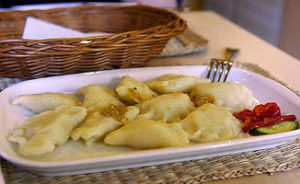
Pierogi is a Polish dumpling that includes mashed potato filing along with meat, vegetable and cheese, of preference, and a flour dough covering on the outside. They are also made as a desert dish filled with cherries, peaches, raspberries, strawberries or other fruit filling. Based upon preference, there are several ways to cook them-steaming the pierogi for the healthy version, for crunchy pierogi you can coat them with bread crumbs and pan fry them, or just pan fry without the bread crumbs. A more modern way of cooking them is to deep fry or BBQ the pierogi.
Pierogi are reminiscent of my father and my aunt in the kitchen preparing a batch of pierogi while speaking in Ukrainian and blissfully discussing memories of their upbringing. My aunt would come to stay with us in the summer; during those months, we enjoyed her cooking including pierogi, stew and chili. I remember my aunt hovering over the cutting board preparing the dough with the rolling pin, and preparing the ingredients to go along with the filling of mashed potatoes, then boiling and frying them-the smell of ground beef, pepper, garlic and onions permeated the living room. Our pierogi would contain ground beef, cheese and onion, after they were boiled and fried, we would eat them with a gallop of sour cream and with sauerkraut on the side. My aunt also made a simpler version of pierogi with mashed potato and cheese as a filling.
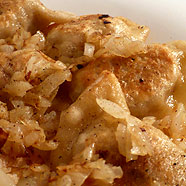

Pierogi, Polish for “pie” is also called varenyky in Ukrainian translated as “boiling liquid.” The origin of pierogi, although it may be disputed, is from Kiev, Ukraine. There is a legend of the Polish people praying for the success of their crops in the 13th century and it is associated with St. Hyacinth, a canonized apostle of the North, in the Roman Catholic Church. St. Hyacinth was best known for his miracles he had witnessed and performed. A most notable miracle he performed was carrying a very heavy religious statue out of harm’s way during an invasion by the Mongols on Kiev. The Saint was also known to preach to the inhabitants of a Poland mountain, Kościelec, where he instructed them to pray, as they were experiencing poverty from the degradation of their crops due to poor weather. These Polish mountain dwellers took heed to the Saint’s request and the next morning, after having prayed for their crop’s yield, they found their crops to be returning to its prior healthy condition. The people of Kościelec prepared the pierogi from the recovered crops to thank the Saint for his divine instructions and for visiting them in their time of need.

The first part of the process of making pierogi is making the dough. The dough starts with mixing flour, egg, water, and salt. Knead the dough and let rest for a half hour then roll the dough with a rolling pin to a flat formation, about a third of an inch thick. Cut out circles with a circular object.
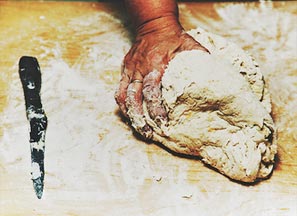
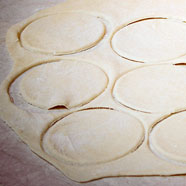
The main filling of this dough is mashed potatoes, in which a batch of these can be made; normally the mashed potato mixture is not seasoned, but it can be seasoned with garlic, herbs and spices, if preferred. The accompanying ingredients to the mashed potatoes are prepared: cooked meat, vegetables, and cheeses. After the dough circles are ready and the mashed potato and accompanying ingredients are lightly incorporated, place a circle of dough into the palm of the hand and place a tablespoon of the mashed potato mixture in the middle of the dough, fold the dough in a half circle and seal the edges with your hands or with a fork. After a batch of pierogi are ready to cook, bring a large pot of water to a boil, lightly salted. Individually place the pierogi into the boiling water and carefully watch them, as when they float to the top, they are finished cooking. Remove each pierogi as it floats to the top of the boiling water. After the pierogi are cooked, they can be placed on a cooling tray. After the pierogi are boiled in water, it is optional to quickly pan fry the cooked pierogi in a light oil until golden brown on the outside. The pierogi can be consumed with accompanying sauces such as sour crème, caramelized onions or other preferred accompaniment.
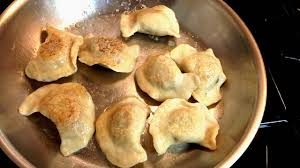
A traditional Polish potato and cheese pierogi is outlined below. Of course, several of the ingredients can be exchanged by preference including a healthy oil instead of butter such as an extra virgin olive oil, or vegetable oil and experiment with different cheese filings. You may also add a cup of well thawed spinach to this recipe to be incorporated in the potato filling.
Pierogi Recipe-
Making the Dough-
-6-7 cups all-purpose flour
-1/2 cup of butter, unsalted at room temperature
-2 Cups of warm water
In a large bowl incorporate the butter and flour with your hands until the flour feels chunky and the butter is blended. Slowly integrate the water into the butter/flour mixture, first add 1 ½ cup warm water, then adding a little more water about ½ to ¾ cup adjusting it so the dough is neither watery or lumpy, only a solid play dough mass. After the dough is at the right texture, prepare for kneading using a lightly floured cutting board. Knead about 5 times, do not overly knead. Cover the dough with a towel and allow to rest for about 45 minutes.
Preparing the Potatoes-
Using a large saucepan, fill with water and lightly salt, bring to a boil then add the peeled potatoes, without the skin. Allow to simmer until the potatoes are tender about 15 minutes. After the potatoes have cooled, drain the water and mash the potatoes with a potato masher or blender while adding a ¼ cup of crème and a table spoon of butter. Set aside potato mixture and place in a covered container. The potato mixture should not be very creamy, there should be a stiffness to the texture.
Shaping the dough-
Place the rested dough back on the lightly floured cutting board and with a rolling pin roll the dough out to a thin 1/8 inch thick. Using a cup size circular object, you can use a glass, cut out the sections of the dough until you have used all of the dough, in circular sizes to about 10.5” – 15” wide circles, depending on how large you want the dumpling to be.
Preparing the ingredients (by choice)-
-2.5 cups of yellow onion (can include ½ green onions)-1 cup of cottage cheese and 1 cup of feta cheese (optional add 1 cup of defrosted, well drained spinach)-2-3 Tablespoons butter (unsalted) or olive oil. Season with salt and pepper
Caramelize the onions in a frying pan. After cooked, allow to cool. In a large mixing bowl add the well-drained spinach to the caramelized onions and add the cheese, incorporate together while not thoroughly blending.
Filing the dough with the prepared ingredients-
Have the cooled potato and ingredient filling ready to start to fill the dough. Take one of the dough circles in the palm of your hand. Spoon the ingredients into the center of the circle (a teaspoon of potato then a teaspoon of the ingredient) fold the circle over the filling to create a half circle then using both hands, take your fingers and press closed the openings of the circle, ensuring there the ends of the circle are sealed, creating a border about 1/8 inch at the outside portion of the half circle. Prepare each of the filled pierogi this way and place on a baking sheet.
Ready to cook-
Bring a large pot of water to a boil, up to 8 quarts of salted water, carefully drop the pierogi in the water so there’s about 6-8 of them in the pot at a time, carefully separating them with the spatula, or slotted spoon, to make sure they don’t stick together. After about 1.5, minutes the pierogi will begin to float to the top- they are done, take them out of the water, one at a time. Cook the batch of pierogi until they are all cooked. Allow to cool.
Consuming the pierogi-
After the boiled pierogi are cooled at room temperature they can be served alongside a preferred side such as a gallop of sour crème, sauerkraut, caramelized mushrooms, sautéed onions or a preferred accompaniment.
Recipe Notes:
The pierogi can be frozen for up to 3 months and reheated for consumption.
The mashed potatoes can be made a day in advance and kept in the refrigerator.
Nutritional Information-
Serving size: Pierogi (3) of the cheese and potato. (fried pierogi-add 90 calories to this serving) calories, 10 g fat, and 25 mg cholesterol, Calories (kcal): 490, Fat (kcal): 21, Fat Calories (g): 190, Saturated Fat (g): 11, Protein (g): 12, Monounsaturated Fat (g): 7, Carbohydrates (mg): 62, Polyunsaturated Fat (mg): 1.5, Sodium (g): 320, Cholesterol (g): 50, Fiber (g): 3
References
Wikipedia, The Free Encyclopedia. https://en.wikipedia.org/wiki/Pierogi Accessed 11/19/16
Wikipedia, The Free Encyclopedia. https://en.wikipedia.org/wiki/Hyacinth_of_Poland Accessed 11/17/16
Saint Hyacinth.com. Founded 1907. http://www.sainthyacinth.com/oursaint.htm Accessed 11/19/16
Tasting Poland Facebook Page, July 2010. http://www.tastingpoland.com/food/pierogi_2.html Accessed 11/19/16
Allrecipies.com. 2016 http://allrecipes.com/recipe/84706/grandmas-polish-perogies/ Accessed 11/19/16
The Taunton Press. 2016 http://www.finecooking.com/recipes/potato-cheese-pierogi.aspx Accessed 11/19/16
Curious Cuisine. 2016 http://www.curiouscuisiniere.com/basic-pierogi/ 11/19/16
O’Neil, Veronica. Voknits.com 2016. http://voknits.com/roasted-garlic-and-cheese-perogies/ Accessed 11/19/16
Polskafoods.com. 2010. http://www.polskafoods.com/how-to-cook-pierogi Accessed 11/19/16
Dunston, Lara. Grantourismotravels.com. 2009. http://grantourismotravels.com/2011/01/18/how-to-make-pierogi-the-secrets-to-dumpling-success/ Accessed 11/19/16
Copyright permission for photos: “The author/owner of Tasting Poland decides to release photos/images described as “by Tasting Poland” under Creative Commons Attribution-ShareAlike (cc by-sa) license, so you are allowed to use of them.”

Carol, thank you for sharing your pierogi recipe. I had no idea how they were made as I’ve only had them in the little box from the freezer aisle at the grocery store! these certainly look a lot better than those and I’m sure they taste even better.